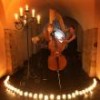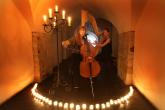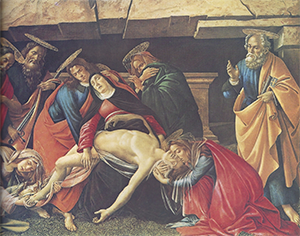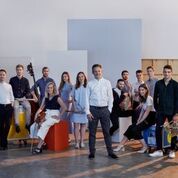A cello and two guitars

“Nothing is more beautiful than a guitar, save perhaps two.”
-Fredric Chopin
Chopin may well have approved of the next series of Bach in the Dark concerts. They feature not just two guitars, but another of his favourite instruments, the cello. Chopin composed just 4 sonatas. Three were for the piano and the 4th was for the cello. His repertoire for solo instruments other than the piano, comprises a Trio for piano violin and cello, and a Grand Duo in E major for cello and piano. The cello was clearly a favourite. The combination of two guitars and cello would surely have pleased him.
In the final series of ‘Bach in the Dark’ for 2011, cellist Rachel Scott performs with guitarists Raffaele and Janet Agostino in a programme founded as always in the music of JS Bach. Scott then takes us into works influenced by Bach – in this case, works by Heitor Villa-Lobos and Philip Glass. The music has mostly been arranged anew for this combination of instruments by Janet Agostino – “and it works very well” says Scott. “We’re doing some Philip Glass (the Opening of Glassworks) – I’m not a huge fan of Glass personally – but I think that it’s actually the perfect beginning to a concert designed to make you stop and slow down. The configuration of two guitars and cello is a well matched partnership”.
Also on the programme is J S Bach’s rarely heard Sonata No 1 in G major for Viola da Gamba, which Scott describes as “a three part fugue, which it works really well for three separate players. I’m really enjoying playing with the warmth of guitar, rather than the coolness of the harpsichord. I find that playing with guitar makes me play far more subtly – as their tone palette is more ‘pastel’ than mine. They have differences which are far more subtle than the cello. I find myself listening really carefully – that’s something I have always loved about the classical guitar – it really draws me in as a listener”.
Extending the influence of Bach into the 20th century, Raffaele and Scott are playing the Aria from Villa-Lobos’ Bachianas Brasilieras which they have performed many times, but Scott needs few reasons to reprise it: “audiences love it, and we both love it. It’s an old friend”.
The Agostinos will together perform more Bach and 9 little pieces, originally for four-hand piano, by Villa-Lobos called Francette et Pia -“a set of completely charming miniatures with snatches of both French and Brazilian music thrown in. They play together so well that sometimes in rehearsals I feel that I’m almost playing with one person not two!”
The programme ends with Janet Agostino’s arrangement of the Theme from Schindler’s List, which says Scott “is a crowd-pleaser anyway – but this arrangement is quite beautiful”.
The combination of cello and guitars is a novel one. Bowed against plucked, deeply sonorous and resonant against a brighter and relatively short-lived sound. Scott agrees. “The only real problem we’ve had is that a sound on a guitar is pretty instantaneous – they pluck, it sounds – whereas on a cello it’s a bit more smudged – so the guitarists play late all the time, which I imagine is quite hard for them. Janet also plays viola – so she understands the physics of the cello really well, which has helped”.
There is however common ground: “The guitar’s range is the same as that of the cello. I used to think of it as a high instrument, as they read in the treble clef, but they actually read an octave higher than they sound – so in terms of the range of notes we play, the instruments have blended really well”.
“I have so enjoyed playing with the subtlety of the guitar – the cello doesn’t have to shout at all, to be musically heard – it’s really just like sinking back in a comfortable sofa!”
Tickets are strictly limited. Call (02)9591-1207 to book.
If you’re out of town you can also catch this concert in Katoomba on October 29th, in Robertson on NOvember 6th, and again in Sydney at the Prince Henry Community Centre on November 18th.







